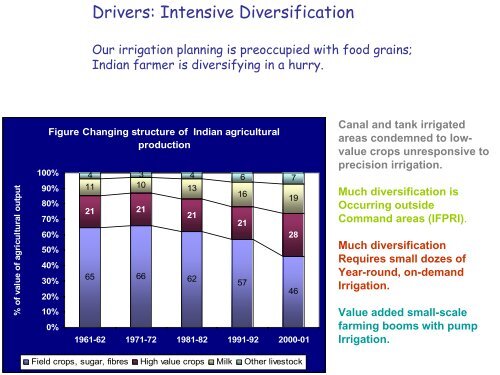Indian Irrigation in Transition - Tushaar Shah
Indian Irrigation in Transition - Tushaar Shah
Indian Irrigation in Transition - Tushaar Shah
Create successful ePaper yourself
Turn your PDF publications into a flip-book with our unique Google optimized e-Paper software.
% of value of agricultural output<br />
Figure Chang<strong>in</strong>g structure of <strong>Indian</strong> agricultural<br />
production<br />
100%<br />
90%<br />
80%<br />
70%<br />
60%<br />
50%<br />
40%<br />
30%<br />
20%<br />
10%<br />
0%<br />
Drivers: Intensive Diversification<br />
Our irrigation plann<strong>in</strong>g is preoccupied with food gra<strong>in</strong>s;<br />
<strong>Indian</strong> farmer is diversify<strong>in</strong>g <strong>in</strong> a hurry.<br />
4<br />
11<br />
3<br />
10<br />
4<br />
13<br />
6<br />
16<br />
7<br />
19<br />
21 21<br />
21<br />
21<br />
28<br />
65 66 62<br />
1961-62 1971-72 1981-82 1991-92 2000-01<br />
Field crops, sugar, fibres High value crops Milk Other livestock<br />
57<br />
46<br />
Canal and tank irrigated<br />
areas condemned to lowvalue<br />
crops unresponsive to<br />
precision irrigation.<br />
Much diversification is<br />
Occurr<strong>in</strong>g outside<br />
Command areas (IFPRI).<br />
Much diversification<br />
Requires small dozes of<br />
Year-round, on-demand<br />
<strong>Irrigation</strong>.<br />
Value added small-scale<br />
farm<strong>in</strong>g booms with pump<br />
<strong>Irrigation</strong>.

















